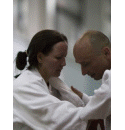Kata Introduction
The Kata section is divided into Randori Kata and Kata. Once you have selected a section you can then choose the desired kata at the top of the page. The idea behind these pages and videos is that you study one or two techniques for later practice at your club. Do not forget to read the notes associated with each kata. These training videos will be added to from time to time. So be sure to return to this site and check for later or updated information.Judo Kata Training
Kata is unique to the Martial Arts and to Judo. There is no equivalent in any other sport or activity. When demonstrating kata the demonstrators should strive for perfect execution of all aspects of the technique. From the initial taking hold, breaking the balance, setting up the throw to the completion of the throw. Good posture and 100% cooperation. Should Uke throw themselves this is not cooperation and it denies Tori the experience of completing a perfect technique.- Kata serves as a training aid.
- Kata serves to provide an understanding of the basic fundamental principals of Judo
- Kata enhances the learning of Judo
- Kata is used to demonstrate Judo to judo players and non judo players alike.
Long after your days of Shiai are over you can continue to practice kata. Be that for competitions or the continued understanding of Judo. It is possible to practice kata well into your seventies and beyond.
Some Important Points
When demonstrating kata different organisations have different requirements. There are however a number of issues that are consistent throughout.- They all perform the same techniques
- They all perform them in the same order
- They all perform a salutation at the start and finish
Whilst books and videos provide another dimension to learning kata, it must be practiced and experienced. There is no substitute. It must be practiced as Uke and Tori. So, get studying and learn the terminology and watch those videos and then get along to a kata course where your instructors can help you polish up the techniques.
If you cannot find a course then check out The South London Area Judo Website in the calendar section and the forum pages for up and coming courses.




